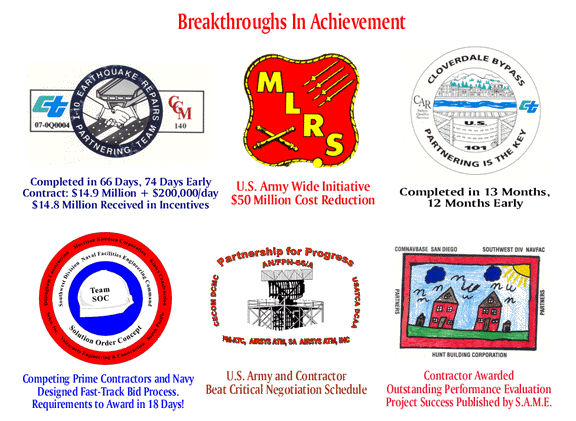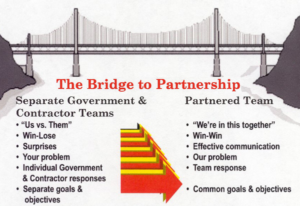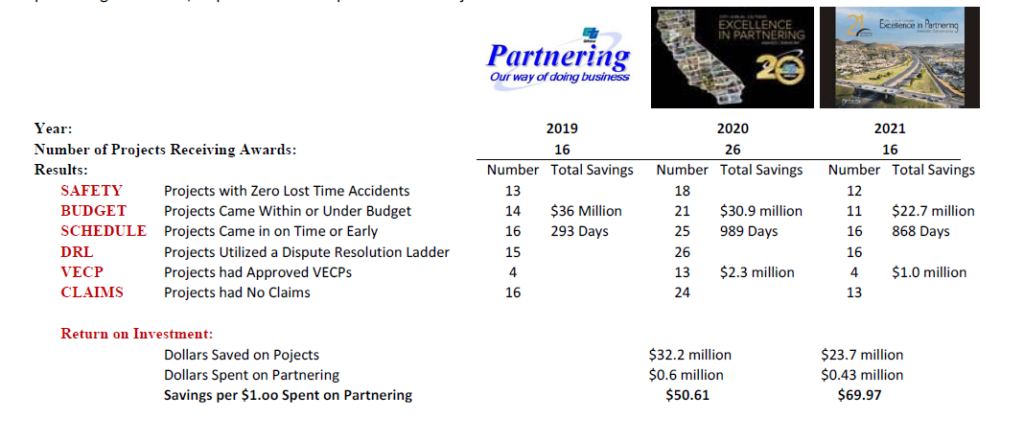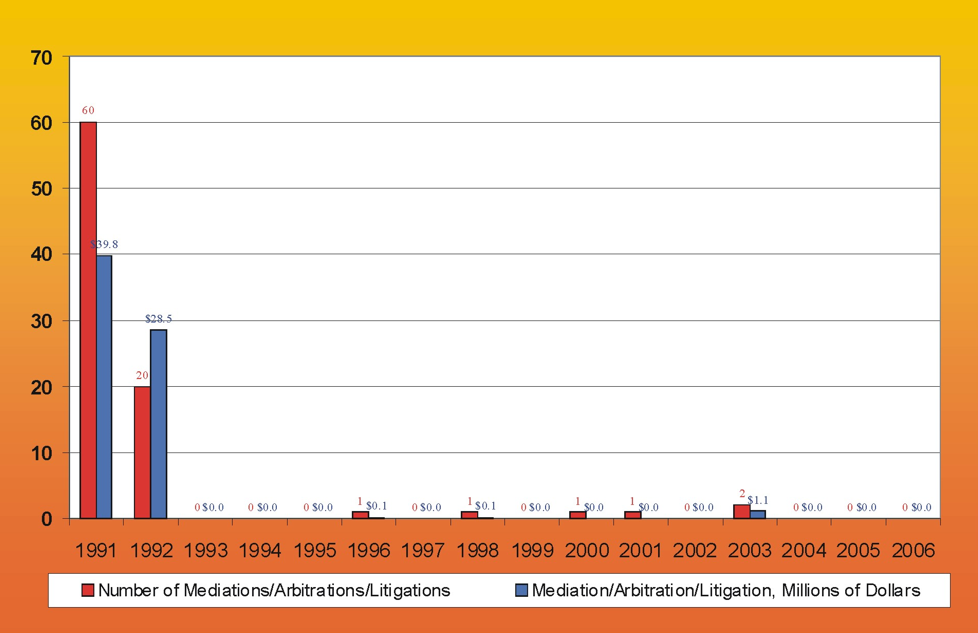About Partnering
Project Partnering:
A Structured Team Building Method
Proven initially for construction teams, it has evolved to create successful project teams for systems acquisition, equipment manufacturing projects, and service contracts.
An Introduction to Partnering
The construction industry became so adversarial that the U.S. competitiveness was threatened. Time and money were being lost in adversarial client, contractor, and subcontractor dealings on large engineering projects – wasted in defensive posturing, case building, developing claims and litigating. In 1987, an industry association, the Construction Industry Institute (CII), took the lead by establishing a task force to search out and structure a culture based on mutual trust, shared goals, open communications, and building on one another to open the door to opportunities – Partnering. The Task Force’s findings set down the basic precepts and methods of partnering.
Partnering has improved the very culture of the construction industry. The U.S. Army Corps of Engineers and the Naval Facilities Engineering Command tried partnering for their military construction projects. The successes of those projects were so dramatic that they established partnering as their preferred way of conducting business with one result being that the Society of American Military Engineers became a leading partnering proponent. Contractors benefited and their industry associations, e.g., the Associated General Contractors of America (AGC), became advocates. Likewise, the designers of heavy engineering projects benefited and their industry associations, the American Institute of Architects, American Consulting Engineers Council, and National Society of Professional Engineers, have “bought in,” become advocates, and provided training materials for their members.
Partnering benefits are not limited to the construction segment. It is a viable management technique that brings divergent organizations together into a motivated team – committed to pull together for the success of the project and the success of the organizations. Partnering provides the project managers, for the first time, with effective tools for project team building – structured methods to establish mutual goals and measures of success, to create open communications, and to rapidly resolve issues. The adaptability of partnering to other industries is typified by the Department of Defense’s success at applying it to the management of contracts for a variety of services, systems, and equipment manufacturing – contracts that have benefited because their managers recognized the value of building a team committed to the cooperative precepts and methods of partnering.
Why Partnering?
Because it Delivers Exceptional Results
Caltrans - Award Winning Results
The California Department of Transportation Excellence in Partnering Awards recognizes Caltrans/ Contractor project teams for utilizing Partnering and its best practices to facilitate successful project implementation. Through Partnering, these award-winning project teams demonstrated the benefits of partnering to Caltrans, its partners, and the public. Click on the image below for evidence of successful outcomes:
ADOT - Results Transitioning to Partnering
The Arizona Department of Transportation began using partnering in the early 90’s primarily to reduce contractor claims on their construction projects. Partnering yielded significant improvements, as shown below:
PMI/ASCE - Eric Larson Survey of Partnering Results
Supported by the Project Management Institute (PMI), Eric Larson of the College of Business, Oregon State University, surveyed their members involved in construction. The 280 responses provided the stunning evidence of the improvements shown below that partnering relationships and processes brought to schedule and cost performance and to overall satisfaction of the project managers. Erik reported these results in the American Society of Civil Engineers (ASCE) Journal of Management in Engineering.
About Us
While a small firm, ATI Systems is recognized to be among the premier partnering facilitators in the nation. Our experience includes over $4 billion in total project value, supporting projects that span the globe from the Indian Ocean Island of Diego Garcia in the west to Djibouti Horn of Africa in the east.
ATI Systems was founded to apply innovative methods to improve the state-of-the-art of project management. In 1992, when the U.S. Army Corps of Engineers, the Construction Industry Institute, and the Associated General Contractors of America began reporting the significant improvements partnering was bringing to construction projects, ATI Systems recognized the tremendous potential of partnering and dedicated the company 100 percent to supporting project teams as their partnering facilitator. That commitment holds true today.

ATI Systems - Extraordinary Partnering Results

ATI Systems has facilitated partnering for hundreds of successful contracts. Examples include a Navy housing maintenance project that received Outstanding reviews and 100% incentive payments for 14 consecutive reviews and major construction projects that have beat their schedules by as much as fifty percent, with attendant cost savings.
We take particular pride in the project to repair the Northridge Earthquake damage that closed the I-10 Santa Monica Freeway. This team’s performance was truly extraordinary. The contractors and the California Department of Transportation’s commitment to partnering were evident when they chose to set aside the first day of this project’s 140-day schedule for a partnering workshop – A Day ultimately valued at either $200,000 as an incentive for early completion or at $205,000 as a penalty for delay. Thirty-eight stakeholders attended the workshop, some having driven all night to meet with their counterparts and participate in defining their management goals and processes for the project. The goals developed that day included completing a safe, quality project in 90 days, 50 days early. The team went on to sign up to an extraordinary mission statement: “We promise to deliver this project as a model of recovery to the people of Los Angeles and its surrounding communities.” Now 27 years later, the stakeholders still take tremendous pride in having met that goal. They reopened this, the world’s most heavily traveled thoroughfare, 74 days early to international acclaim!



